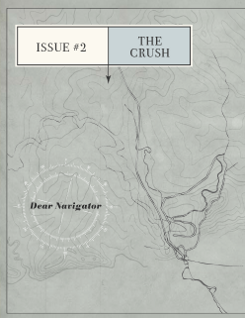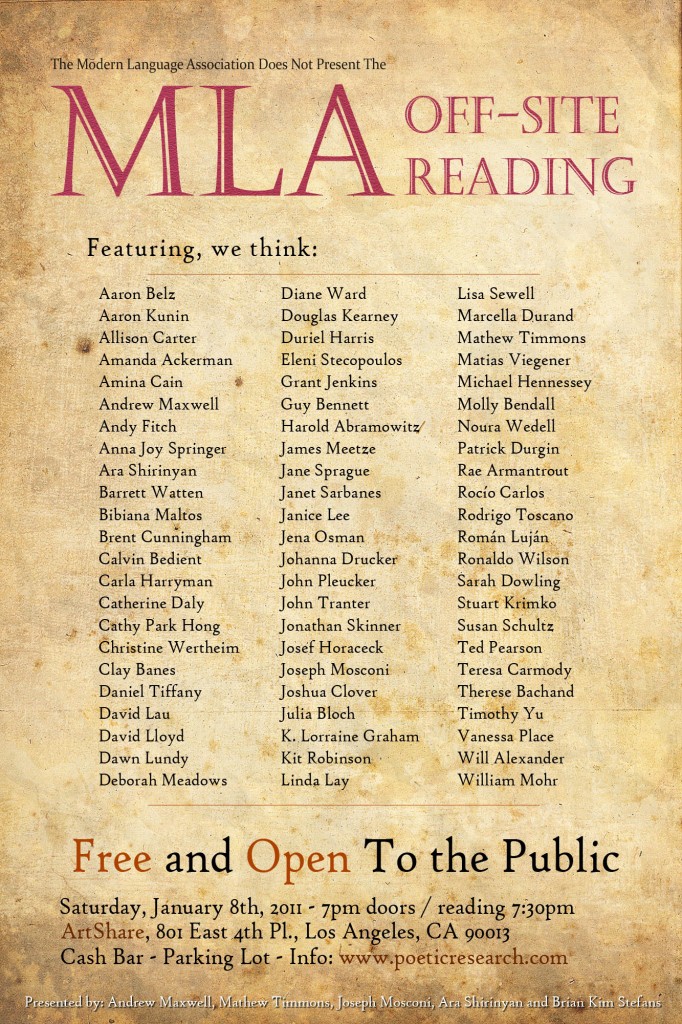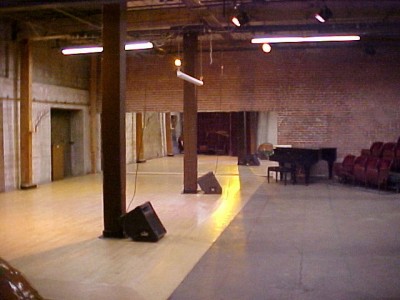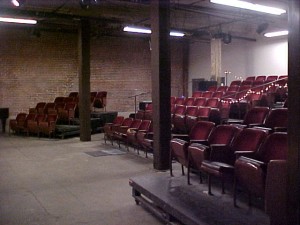DEAR NAVIGATOR
HTTP://WWW.SAIC.EDU/DEARNAVIGATOR
The School of the Art Institute of Chicago and the Master of Fine Arts in Writing Program, in conjunction with the DEAR NAVIGATOR editorial staff, are proud to announce the second (double!) issue of DEAR NAVIGATOR, an electronic magazine of contemporary art + writing, featuring emerging + established artists from around the globe.
[Because winter isn’t cold enough, we’re striking again while the iron is hot—with twice the content in our first double issue!]

Bolstered by a distinguished board, DEAR NAVIGATOR creates a forum for innovative writing that works as art object, critical opus, interdisciplinary essay, poetic form, meta-text, and philosophical offering. Housed by the MFA in Writing Program at SAIC, DEAR NAVIGATOR appears quarterly and electronically, publishing a handful of established and up-and-coming writers per issue, while shepherding associated projects, including curated reading and performance series.
We couldn’t be more delighted to announce the debut of Issue 2: The Crush, which features new multidisciplinary work from:
• Eric Baus
• Susan Daitch
• Hamdy el-Gazzar (translated by Humphrey Davies)
• William Fuller
• Kristi Maxwell
• Nick Montfort and Stephanie Strickland
• Eleni Sikelianos
• Zachary Schomburg
• Kate Zambreno
Follow us on Twitter: @dearnavigator
Fan us on the FBOOK: Dear Navigator
Join our email list: dn.writing@gmail.com
**
DEAR NAVIGATOR EDITORIAL BOARD:
Dan Beachy-Quick, Kenneth Goldsmith, Matthea Harvey, Yusef Komunyakaa, W. Martin, Peter Orner, Vanessa Place, Patricia Smith, Brian Kim Stefans, Saviana Stanescu, and Cole Swenson
MASTHEAD : :
Editor: Elizabeth Metzger Sampson
Curator and Content Editor: Kristi McGuire
Editor-at-Large: Chris Cuellar
Associate Editors: Rebecca Elliott, Heather McShane, Edmund Sandoval, and Colin Winnette
Spiritual Advisor: Sarah Archer
: : END TRANSMISSION + STAY TUNED
(HTTP://WWW.SAIC.EDU/DEARNAVIGATOR)

I’ve been working on a project based on my courses on electronic literature. I’ve been teaching it for over five years now, and am getting a sense of the texts that I use. However, I always feel like I’m building the class from the ground up every time, so I thought it would be cool to collect my materials into some sort of “anthology” to have on hand.
I also wanted to create a user-friendly, brief introduction to the field for people not in school, or who have no access to such a class. There are numerous places to find criticism and writing related to electronic literature, but they often contain such a huge amount of text that the newbie would not know where to start. Consequently, they are often very academic in discourse level, which is alienating to someone unfamiliar with the jargon.
This collection is intended to be for students, not my fellow artists and academics, but I hope there is something interesting to find in here for you as well. I’m sure we all have different approaches — for instance, I assign exercises in Scratch and Wix, which won’t be reflected in this list, and I tend to stay away from historical readings or computer science — but I’ve prowled several of your syllabi and websites in the creation of this list. So this can be seen as a continuing conversation.
This is a “freeware” anthology in that I only limited myself to works that were already available on the web. In a few cases, this might be in the form of bootlegs — sometimes it’s hard to tell what has been approved, since not everyone uses a Creative Commons license — but I limited myself to pieces that don’t require special privileges or subscription costs. (In one case, the essay works on my iPad but not laptop; in another, I thought it was freely available but it was not, but I’ve kept it in anyway since the author’s a friend of mine.)
I hope to edit a book to sell on Lulu for cost that will include primarily excerpts from the works, along with editorial glosses. The model is the “Documents in Contemporary Art” series, which are readable in a few days, as opposed to the often mammoth books on digital culture published by MIT (much as I like them).
The website that I am creating for this anthology will contain the essays in .pdf form (reset, since many of these pages are nearly illegible), a .pdf of the edited book with my editorial commentary, a page of videos I often use when teaching, a “ten week course” that is a series of essays, links and assignments based on my course, and other materials such as a bibliography, via Amazon’s “listmania” feature, of electronic literature books.
This is not a complete overview of the state of the field, or an attempt to create a “canon.” If the image here is skewed or flawed, it’s only because it’s meant to be a launching pad for an independent investigation of the genre, either as a scholar or artist. The fact of the matter is, there isn’t a whole lot of great writing on the works themselves — more of the e-lit writing is about its theory and potential — so I tried to include what I could. If you know of better deep readings of a particular e-literature piece, please let me know.
Inspired by the New Media Reader, edited by Noah Wardrip-Fruin and Nick Montfort, this selection is a mixture of theoretical texts, creative works, manifestos, critical readings, interviews, Wikipedia articles, encyclopedia entries, lists, blog posts, and other miscellany. It only includes work that can be included in a book (or a .pdf). Any feedback you have is welcome!
Foundations
- F. T. Marinetti, “Words in Freedom†(1913), “Geometric and Mechanical Splendor and the Numerical Sensibility†(1917?)
- Wassily Kandinsky, “Concerning the Spiritual In Art†(1913)
- Walter Benjamin, “The Work of Art in the Age of Mechanical Reproduction†(1936)
- Jorge Luis Borges, “The Garden of Forking Paths†(1941), “The Library of Babel†(1941) and “Pierre Menard, Author of Quixote†(1941)
- Eugen Gomringer, “From Line to Constellation†(1954); “The Poem as Functional Object†(1968)
- Noigandres (Augusto de Campos, Decio Pignatari and Haroldo de Campos), “Pilot Plan for Concrete Poetry†(1958)
- Susan Sontag, “Happenings: an art of radical juxtaposition†(1966)
- Stanford Encyclopedia of Philosophy, “The Turing Test†(2008)
- Larry Hauser, “Chinese Room Argument†(2001)
- Güven Güzeldere and Stefano Franchi, “Dialogues With Colorful Personalities of Early AI†(1995)
- Donna Haraway, “A Cyborg Manifesto: : Science, Technology, and Socialist-Feminism in the Late Twentieth Century†(1991)
- N. Katherine Hayles, “Virtual Bodies and Flickering Signifiers†(1993)
- Espen Aarseth, “Ergodic Literature†(1997)
- Lev Manovich, “Database as Symbolic Form†(1999)
- John Cage, album notes to “Indeterminacy: New Aspect of Form in Instrumental and Electronic Music†(1959)
- Jackson MacLow, “The Twin Plays†(1966)
- Sol Lewitt, “Paragraphs on Conceptual Art†(1967), “Sentences on Conceptual Art†(1969)
- Hakim Bey, “The Temporary Autonomous Zone†(1991)
- Charles Bernstein, “Poetics of the Americas†(1996)
- Ted Nelson and Tim Berners-Lee, “The Best Summary of My Work†(1999)
Writing Making Stealing
- Douglas Englebert, “Augmenting Human Intellect: A Conceptual Framework†(1962)
- William S. Burroughs, “The Cut-Up Method of Brion Gysin†(1978)
- Gilles Deleuze and Felix Guattari, “A Thousand Plateaus†(1987)
- Shelley Jackson, “Stitch Bitch†(1997); Mark Amerika, “Stitch-Bitch: An Interview with Shelley Jackson†(1998)
- Aram Saroyan, “Pages†(1969)
- mez, “_The Art of M[ez]ang.elle.ing: Constructing Polysemic & Neology Fic/Factions Online_“
- Rita Raley, “Interferences: [Net.Writing] and the Practice of Codework†(2002)
- John Cayley, “Writing on Complex Surfaces†(2005)
- Cox, Geoff, Alex McLean and Adrian Ward, “The Aesthetics of Generative Code†(2006)
- Marjorie Perloff, “Conceptualisms Old and New†(2007)
- Charles Bernstein, “Experiments†(1996-2010)
- Darren Wershler, “The Tapeworm Foundry, andor, the dangerous prevalence of imagination†(2000)
- Nick Montfort and William Gillespie, “2002: A Palindrome Story†(2002)
- Toadex Hobogrammathon, “Name: A Novel†(1995?)
- Bill Seaman, “Approaches to Interactive Text and Recombinant Poetics†(2004)
- Encyclopedia Britannica, “The Influence of Erwin Piscator†(2010)
- Edward Tufte, “PowerPoint Does Rocket Science–and Better Techniques for Technical Reports†(2005)
- Lawrence Lessig, “What Orrin Understands†(2001); Wikipedia, “Creative Commons Licenses†(2010)
- Kenneth Goldsmith, “A Week of Posts to The Poetry Foundation Blog†(2007)
- Mike Magee, Kasey Mohammed and Gary Sullivan, “The Flarf Files†(2003); Dan Hoy, “The Virtual Dependency of the Post-Avant and the Problematics of Flarf: What Happens when Poets Spend Too Much Time Fucking Around on the Internet†(2006)
Text Image Sound
- Situationist International, “Detournement as Negation and Prelude†(1959)
- Alice Becker-Ho, “The Language of Those in the Know†(1995)
- Internet Encyclopedia of Philosophy, “The Bakhtin Circle†(2010)
- Keith Obadike, “Blackness for Sale†(2001)
- Giselle Beiguelman, “Hacktivism? I didn’t know the term existed before I did it: An Interview with Brian Kim Stefans†(2003)
- Josh On, “From They Rule to We Rule: Art and Activism†(2002)
- Noah Wardrip-Fruin, “Regime Change & News Reader†(2004)
- Paul Chan, “The text you write must desire me: fonts as the penultimate interactive artform, second only to sex†(2001)
- John Cage, “Experimental Music†(1957)
- Brian Eno, “Generative Music†(1996)
- John Oswald, “Plunderphonics, or Audio Piracy as a Compositional Prerogative†(1985)
- Charles Bernstein, “Close Listening: Poetry and the Performed Word†(1998)
- Kurt Schwitters, “Ursonate,†score (1922-32)
- John Cayley, “Bass Resonance†(2005)
- Johanna Drucker, “The Art of the Written Image†(1998)
- Elaine Equi, “The Poetry of Ed Ruscha†(2004)
- Marjorie Perloff, “Screening the Page / Paging the Screen†(2006)
- Thom Swiss, “An Interview With Young Hae-Chang Heavy Industries†(1922); Jessica Pressman, “Reading the Code between the Words: The Role of Translation in Young-hae Chang Heavy Industries’s Nippon†(2007)
- Josh Spear, “Interview with Jason Nelson†(2010)
- Brian Kim Stefans, “An Interview with William Poundstone†(2002)
Reading Looking Doing
- Braulio Taveres, “Raymond Queneau†(1999); Raymond Queneau, “Yours for the Telling†(1967)
- Guy Debord, “Theory of the Derive†(1958)
- Roland Barthes, from “S/Z†(1973)
- Catherine Burgass, “A Brief Story of Postmodern Plot†(2000)
- Harry Mathews, “Histoire†(1988)
- Jill Walker, “Piecing Together and Tearing Apart: Finding the Story in afternoon†(1999)
- Shayna Ingram, “Reconsidering the Walls of Literature through Hypertext†(2008)
- Mikhail Epstein, “Hyper-Authorship: The Case of Araki Yasusada†(2000)
- Wikipedia, “mouchette.org†(2010)
- Nick Montfort, “Toward a Theory of Interactive Fiction†(2003)
- Roberto Simanowski, “‘Reading “Text Rain’†(2005)
- Stuart Moulthrop, “Pax, Writing and Change†(2008)
- David Rokeby, “The Computer as a Prosthetic Organ of Philosophy†(2003)
- Jesper Juul, “Games Telling Stories†(2001)
- Henry Jenkins, “Game Design as Narrative Architecture†(1999)
- Alex Galloway, “Social Realism in Gaming†(2004)
- David Young, “Interview with Erik Loyer†(2010)
- Alexandra Saemmer, “Ephemeral passages—La Série des U and Passage by Philippe Bootz: a close reading†(2009)
- Marjorie Perloff, “The Music of Verbal Space: John Cage’s ‘What You Say’†(2004)
- Peter Lunenfeld, “Towards Visual Intellectuality: The Mediawork Pamphlet Series†(2010)
Genre Jams
- Ulisses Carrion, “The New Art of Making Books†(1975)
- Robert Coover, “The Babysitter†(1969); “The End of Books†(1992)
- Bruce Andrews, “Electronic Poetics” (2002)
- Stephanie Strickland, “Born Digital†(2009)
- Christian Bök, “The Piecemeal Bard Is Deconstructed: Notes Towards a Robopoetics†(2001)
- Daniel C. Howe, “The RiTa Library†(2007?)
- Noah Wardip-Fruin, “Playable Media and Textual Instruments†(2005)
- Lev Manovich, “Understanding Hybrid Media†(2007)
- Michael Mateas, “A Preliminary Poetics for Interactive Drama and Games†(2005)
- Nicholas Bourriaud, “Relational Form†(1998)
- Kanarinka, “Interview with Giselle Bieguelman†(2003)
- Jill Walker, “Distributed Narratives: Telling Stories Across Networks†(2004)
- Danny Snelson, “Heath: prelude to tracing the actor as network†(2007)
- Andrew Lawless, “Identity correction – Yes Men style. Interview with Andy Bichlbaum.†(2005)
- Anonymous, “Rules of the Internet†(2010); Julian Dibbell, “The Assclown Offensive: How to Enrage the Church of Scientology†(2009)
- Paul Virilio, “The Information Bomb†(2000)
- Matthew Fuller, “Software Studies: A Lexicon†(2008)
- Nick Montfort, “ppg256 (Perl Poetry Generator in 256 characters)†(2008)
- Eduardo Kac, “Biopoetry†(2003)
- Steven Voyce, “The Xenotext Experiment: An Interview With Christian Bök†(2007); Christian Bök, “The Xenotext Experiment†(2008)
The Poetic Research Bureau presents…
NADA GORDON & K. LORRAINE GRAHAM
Sunday, January 2, 2011 at 7:30pm
The PRB@The Public School
951 Chung King Rd.
Los Angeles, CA
Doors open at 7:00pm
Reading starts at 7:30pm
$5 donation requested
Nada Gordon is the author of several poetry books: Folly, V. Imp, Are Not Our Lowing Heifers Sleeker than Night-Swollen Mushrooms?, and foriegnn bodie– and an e-pistolary techno-romantic non-fiction novel, Swoon. Her new book, Scented Rushes, is just out from Roof books. A founding member of the Flarf Collective, she practices poetry, song, dance, dressmaking, and image manipulation as deep entertainment. She blogs at ululate.blogspot.com.
K. Lorraine Graham is the author of Terminal Humming, (Edge Books), recent work has appeared in Eleven Eleven, the Zaoem International Poetry Exhibition at the Minardschouwburg, Gent, Belgium, and the Infusoria visual poetry exhibition in Brussels. She lives in Carlsbad, CA, with her partner Mark Wallace and Lester Young, a pacific parrotlet. You can find her online at spooksbyme.org.
www.poeticresearch.com

And who said conference poetry wasn’t sexy? You say MLA. We say MLAwesome.
Zero-sum speed-sport pachinko-style poetasty. Everything poetry is not supposed to be –– for four-and-a-half hours!
This is the shadow convention. Screw the well-lit spaces. Guidebook for conventioneers ahead.
Doors open at 7:00, the reading will start at 7:30.
Poets will read for 3 minutes (or less); we place violators on the subway to the sea, MTA-guaranteed, by which we mean they shall never arrive. We have to be out of the venue by midnight, so windbags will be haters. If it sounds like a puptent happening, get this: it is a proper theater, so at least there are no chairs to fold!
There is a parking lot, and during the event there will be an inexpensive cash bar, but we have no other details on the space. It looks really great in the photos.
Did we mention there’s a grand piano?


Artshare
http://artsharela.org
801 East 4th Pl.
Los Angeles, CA
Here is a Google map that shows how to get there from the convention center. It’s not a short walk, and there a few streets you might want to avoid.
View Map
For instance, I would probably take Hope or possibly Grand from 11th to 7th, and then Spring from 7th to 2nd. I’ll have more details on the best way to travel from the convention center to the location. Of course, there will be cabs available from your hotels.
Another option is to take the Metro, which costs $1.50 and leaves right from the convention center and lands in Little Tokyo. It stops running at midnight, however.
View Map
And then there is the bus, which despite what you might have heard, runs very well in Los Angeles. I take it to work every day. You’ll get a pretty good tour of downtown LA as well. It costs a $1.50 exact change, but takes bills of course. There are several optional routes.
View Map
The website taxicabsla.org has a complete list of phone numbers for taxis that serve the area. The area that includes downtown is C. Taxis can be pricey but the distance is so short and there will be no traffic at that hour downtown. There are also taxi stands at the various hotels downtown, though I don’t know much more about this as I never take taxis. Here are the relevant numbers from the site:
United Independent Taxi
(213) 483-7660 or
(310) 821-1000 or
(800) 411-0303
Yellow Cab
(310 or 213) 808-1000 or
(800) 200-1085
Bell Cab
(888) 235-5222 or
(800) 666-6664
Beverly Hills Cab Company
(310 or 800) 273-6611
Checker Cab
(310 or 800) 300-5007
City Cab
(818) 252-1600 or
(800) 750-4400
Independent Taxi
(323) 666-0050 or
(800) 521-8294
Near the site of the reading are a lot of neat restaurants and bars. Traction Ave. is kind of the new hip area of downtown. Down 3rd street is SCI-ARCH, a great school with a fascinating lecture series. The Google map below shows you some (but not all — click on the unnamed dots) of the restaurants in the area. Did I mention it’s near Little Tokyo?
View Map
Andrew Maxwell offers the following recommendations for restaurants in the neighborhood:
Under $15:
Daikokuya: Still some of the best ramen in LA, with excellent cloudy pork bone broth. It’ll be a wait, but if it’s cold, it’s very worth the wait.
Senor Fish: Local mom’n’pop Mexican chain, but well above the mean for cheap eats. Get the fish taco special if your cash is low, and just want a decent, tasty lunch.
Suehiro Cafe: Solid bento box and noodles place. Japanese comfort food. Solid, if not transcendent, easy to get in, open until 3am.
$15-25:
Izayoi: Japanese Izakoya joint (small plates). Big with locals and the kids. Can be inconsistent, but also cheaper than some other options, and has its on nights.
Shabu Shabu House: Popular shabu joint, steamy hot broth, excellent sauces — folks swear by it, but can be a bit of a wait at times.
Wurstküche: Craftsman beers and homemade brats. Gastropub in a German beer hall, often packed, long tables, family style. Good stuff, but can be 20 min wait to order and get food.
$25 and above:
Sushi Gen: One of the better sushi joints in LA. Definitely will want to call ahead. Not so cheap, but definitely very solid sushi.
Lazy Ox Canteen: Bistro/gastropub, a little more upscale, one of the better young chefs in LA. Can usually get in for lunch, but is more of a reservations place on evenings and weekends.
In terms of bars and cafes, Mathew Timmons offers the following:
Villains Tavern – great for before or after reading – a kinda steampunk nowheresville, somewhere old west parisian feel – beautifully designed space – with outdoor patio and lots and lots of heat lamps – like 30 beers on tap – half of them belgians – paired with shots for $8 and old school fancy cocktails – nice balcony – Cherry Bacon Marmalade Burger -Â Â grilled cheese with cave-aged cheddar and tamarind chili -Â they also have veggie options though I’m not sure about vegan
Urth Caffe – a great place to go before the reading – they aren’t open late – but they have really amazing coffee and tea and great sandwiches and food – very down to earth stuff – not cheap but not really expensive either
Church & State – only open until 11pm – good for before the reading – somewhat expensive but great cocktails – great coffee – very good food
(This escapade is sponsored, organized, and hosted by Brian Kim Stefans, Matt Timmons, and PRB Directors Andrew Maxwell, Joseph Mosconi, and Ara Shirinyan. If you see ’em, give ’em a shake or a drink.)




